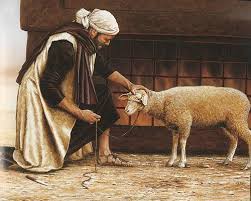The Five Offerings of the Tabernacle:
Christ, Our Sacrificial Offering
Leviticus 1:1 to 7:38
There are five different offerings connected with Isra’el’s worship of ADONAI. When viewed as a whole, they point to the one perfect offering of Christ. When considered individually, they show the different aspects of the ministry of Yeshua, as the Sacrifice sufficient for the need of every human soul. And because Jesus Christ can be seen in each of these offerings, it should come as no surprise to us that the gospel can also be seen.
The five different classifications made by the Spirit of God can be easily understood by the names of the offerings themselves: (1) the sin offering, (2) the guilt offering, (3) the burnt offering, (4) the grain offering, and (5) the peace offering. The first two reveal how Messiah alone bore the sins of a guilty world, and the last three tell how God restored our relationship with Him.

There were five different animals or birds that were acceptable offerings to ADONAI: (1) an ox, (2) a lamb, (3) a goat, (4) a dove, and (5) a young pigeon. The ox speaks to us of Messiah the strong One, patient and faithful as the Servant of God, obedient unto death (Philippians 2:8 KJV). The sheep and the lamb remind us of the Lord’s meekness and submission to His Father’s will. For Yeshua was led like a Lamb to the slaughter, and as a sheep before his sheers is silent, He did not open His mouth (Isaiah 53:7). Jesus was the Passover Lamb without blemish or defect (First Corinthians 5:7, First Peter 1:19). The goat is a picture of Christ, the sinner’s Substitute, bearing the iniquity of us all (Leviticus 16:22).
All five of these offerings were brought to ADONAI in faith. Those who believe in, or trust in Christ are always saved by faith, either in the TaNaKh, or the B’rit Chadashah. The blood of bulls and goats were interest only payments for the Israelites. Those offerings could by them time, but they could not buy them forgiveness. When they brought their sacrifices they believed that the God of Abraham, Isaac and Jacob would accept it as a substitute for their sin and become a pleasant aroma, an offering made to ADONAI by fire. It did not completely do away with his sin, once and for all. Only the coming of Christ could do that. Nevertheless it would cover the sin of the Israelite who loved God only for a short time, until he felt the deep sense of sin gnawing at him again. Then he would return to the Tabernacle, or later the Temple, with another sacrifice in hand. This happened over and over again for his entire lifetime. It was a bloody, smelly business. One can only imagine the flies in the desert around all the blood. But he would never forget that a blood sacrifice was needed for his sins to be forgiven. And once his sins were forgiven, he would be at peace with God.



Leave A Comment